Indigenous cultures preserved food without sugar because they mastered sophisticated natural preservation techniques aligned with their environment and traditional ecological knowledge. You'll find they relied on methods like smoking, drying, fermenting, and earth storage to extend food shelf life. They understood how to harness natural elements like salt, smoke, wind, and cool underground temperatures to prevent spoilage. Through generations of practice, they developed preservation systems that worked with seasonal cycles and local resources. Their time-tested methods didn't just preserve food – they maintained nutrition, flavor, and cultural traditions. There's a world of ancient wisdom behind these sugar-free preservation practices.
Ancient Wisdom in Food Storage
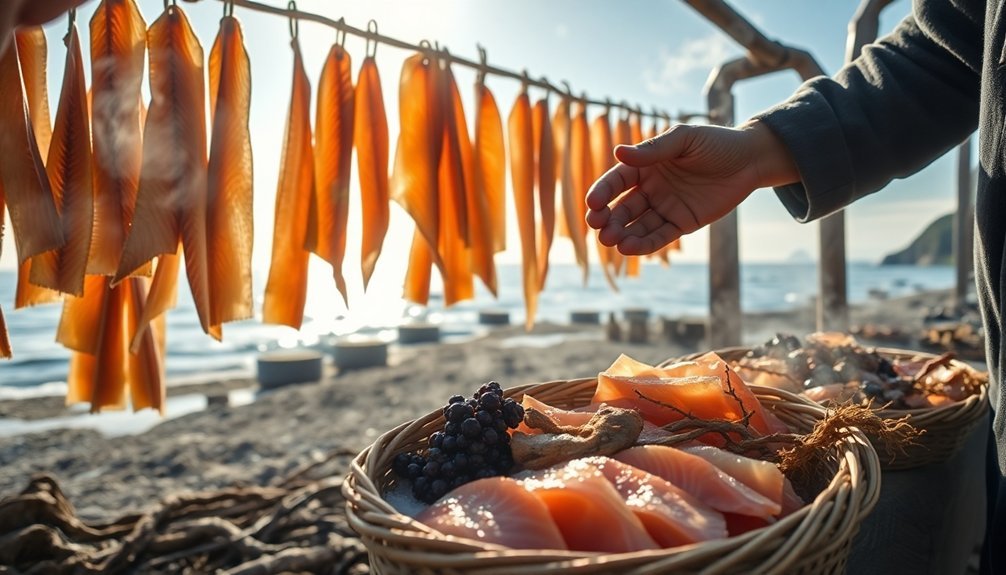
Through the ages and across cultures, Indigenous peoples developed sophisticated food preservation techniques that we're still learning from today. Their methods were deeply rooted in ecological knowledge and community practices, reflecting an intimate understanding of local environments and seasonal patterns.
You'll find that Indigenous communities mastered multiple preservation approaches, each suited to their specific climate and needs. The Hopi and Navajo in the American Southwest perfected the art of drying, using the hot, arid climate to preserve fruits, vegetables, and meats. They'd concentrate flavors while removing moisture that could lead to spoilage. These preservation practices were essential in maintaining nutritional value throughout extended storage periods.
When you examine their storage methods, you'll notice they weren't just practical – they were ingenious. Communities used natural features like cellars, caves, and cool streams to maintain their food supplies.
They'd combine different preservation techniques, such as smoking after drying, to create more durable preserved foods. This extensive approach to food storage wasn't just about survival; it was about maintaining diverse diets throughout the year and preserving cultural traditions that brought communities together in shared work and celebration.
Salt as Nature's Preservative
Resourcefulness drove Indigenous peoples to harness salt's remarkable preservative power, transforming this natural mineral into a cornerstone of food security. You'll find that these communities sourced their salt from various natural deposits, including salt pans, coastal waters, and salt lakes, adapting their collection methods to their local environment. Many communities relied on ancestral knowledge, passed down through generations, to locate and harvest salt effectively.
When you examine salt's scientific role in preservation, you'll understand why it was so effective. Salt works through osmosis, drawing moisture out of food and creating an environment where harmful bacteria can't thrive. This process was particularly essential for preserving meat and fish, which you'd need to store for extended periods, especially during harsh winters or scarce seasons.
You'll notice that salt preservation wasn't just about survival – it carried deep cultural significance. Indigenous communities incorporated salt into their religious ceremonies and traditional medicine, viewing it as a symbol of purification and healing.
They'd develop extensive trade networks around salt, fostering relationships between different groups. The preservation techniques they developed, like curing and brining, weren't just practical solutions – they represented a profound understanding of nature's resources and their sustainable use.
Smoke and Sacred Preservation
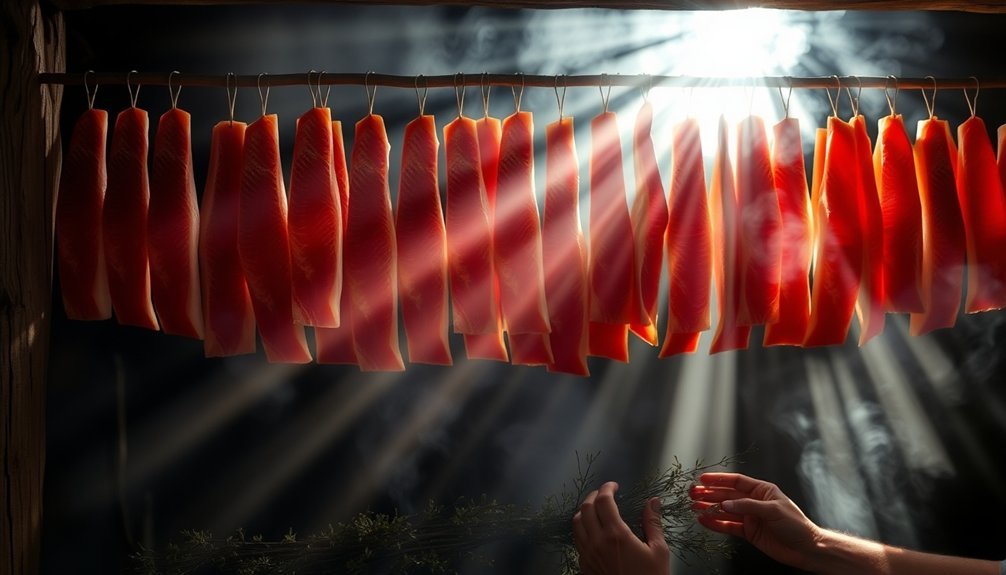
When you explore traditional smoking techniques, you'll discover an intricate preservation method that Indigenous peoples mastered over generations.
They've perfected the art of using hardwoods like oak, hickory, and maple, while carefully avoiding softwoods that could taint food with bitter resins. You'll find they maintain precise temperatures between 150°F and 225°F to create the perfect balance of smoke and heat. Nutrient-dense jerky emerges from smoking meats like deer and moose, creating a portable food source.
The process isn't just about preservation – it's a deeply cultural practice that brings communities together.
You'll see how Indigenous peoples combine carefully selected woods with aromatic additions like juniper berries and thyme to create distinct flavor profiles. They'll use apple wood for poultry, sugar maple for fish and beef, and lilac for seafood and cheeses.
What's remarkable is how smoking reflects a profound understanding of environmental cycles and sustainability.
You're witnessing a practice that's adapted to seasonal changes while conserving resources and respecting the land.
Through temperature and humidity control, Indigenous peoples have developed both cold and warm smoking techniques, ensuring food availability throughout the year while maintaining their cultural heritage and food sovereignty.
Environmental Knowledge Shapes Methods
The deep relationship between Indigenous peoples and their environment extends far beyond smoke preservation methods. Through Traditional Ecological Knowledge (TEK), you'll find that Indigenous communities have developed intricate food preservation systems by carefully observing and responding to natural cycles.
They've mastered the art of reading seasonal changes, following lunar patterns, and studying celestial movements to determine prime times for harvesting and preserving food.
You'll see this environmental wisdom reflected in their sophisticated territorial management practices, which have successfully protected 80% of remaining biodiversity in Indigenous lands.
From hunting and gathering to farming and aquaculture, these communities have created preservation methods that work in harmony with nature's rhythms.
They're now adapting to modern challenges by combining their ancestral knowledge with contemporary technology, especially in regions where climate change threatens traditional preservation methods.
When you understand Indigenous food preservation, you're looking at a complex system that interweaves environmental stewardship, cultural identity, and spiritual practices.
This holistic approach guarantees that communities can maintain their traditional foodways while adapting to environmental changes, demonstrating how ancient wisdom continues to evolve and remain relevant.
Living With Seasonal Abundance

When you examine indigenous food preservation practices, you'll notice how communities carefully tracked nature's rhythms to determine ideal harvest times for different food sources.
You'll find that these societies developed intricate storage systems to make the most of seasonal abundance, ensuring sustenance throughout leaner periods.
The practice of preserving foods at their peak ripeness and abundance wasn't just practical – it formed the foundation of sustainable food security that carried communities through entire seasonal cycles.
Natural Harvest Timing Patterns
Indigenous peoples mastered nature's timing by developing intricate systems for predicting and following seasonal harvests. They'd observe specific natural cues that signaled when certain foods would be ready. For example, when you'd see Oceanspray blooming, you'd know butter clams were ready to harvest, or when Soapberries ripened, you could expect Sockeye salmon runs to begin.
These natural indicators weren't random – they were part of a sophisticated understanding of seasonal rhythms that guided all aspects of life. You'd move to different locations based on these patterns, following the availability of resources throughout the year. The moon's phases also played a vital role in determining when to harvest different foods.
Key harvest indicators you'd watch for:
- Salmon berry blossoms bursting open to signal halibut and eulachon returns
- Sagebrush buttercup's yellow petals announcing Spring salmon migrations
- Lupine's purple spikes marking marmot hunting season
- Moon phases revealing ideal times for gathering root crops and leafy plants
This knowledge wasn't just practical – it was deeply embedded in cultural traditions and passed down through generations, ensuring communities could sustainably harvest year after year.
Storage For Future Needs
Throughout generations, preserving abundant seasonal harvests meant the difference between survival and starvation during lean months.
You'll find that indigenous communities developed sophisticated storage systems and preservation methods that didn't rely on sugar or modern technology.
When you look at traditional storage practices, you'll see how communities created dedicated storage rooms and specialized containers to protect their preserved foods.
They'd carefully select locations that maintained ideal temperature and humidity levels, ensuring their dried, smoked, and fermented foods remained viable for extended periods.
You'll notice how these storage methods weren't just practical solutions – they were deeply integrated into community life.
The elderly and children would participate in monitoring stored foods, turning dried items regularly, and checking for any signs of spoilage.
As nomadic tribes moved with the seasons, they'd establish temporary storage solutions that were both portable and effective.
These storage practices supported food sovereignty and economic stability.
You'll find that by effectively storing preserved foods, communities maintained access to traditional, nutrient-rich foods throughout the year, reducing their dependence on external food sources and ensuring their cultural practices continued across generations.
Preserving Peak Season Bounty
Managing peak season abundance required sophisticated preservation methods that turned fleeting harvests into lasting sustenance. You'll find that Indigenous communities mastered techniques like drying, smoking, and fermenting to preserve their peak-season bounty without relying on sugar. These methods weren't just practical – they carried deep cultural significance and helped maintain connections to the land.
When you're preserving foods at their peak, you're capturing maximum nutrition and flavor while ensuring year-round availability. Indigenous peoples used natural elements like sun and wind for drying, while smoking added both preservation properties and distinctive flavors to foods. Fermentation transformed fresh ingredients into nutrient-rich staples that could last through lean times.
- Sun-dried chiles hanging in vibrant red clusters from wooden rafters
- Fish fillets smoking over aromatic wood, creating wisps of preservation-bringing smoke
- Berries spread on woven mats, drying in the warm breeze
- Clay vessels filled with fermenting vegetables, bubbling with beneficial bacteria
You'll notice these preservation methods were often communal activities that strengthened cultural bonds while ensuring food security. Through careful seasonal planning and traditional knowledge, communities maintained diverse, resilient food systems that sustained them throughout the year.
Cultural Heritage Through Preservation
When you explore native food preservation techniques, you're connecting with centuries of ancestral wisdom that's been carefully passed down through generations.
You'll find these time-tested methods strengthen community bonds, as families and neighbors often gather to preserve seasonal harvests together.
Through preservation activities like smoking, drying, and fermenting, you're not just saving food – you're actively participating in keeping cultural traditions alive.
Ancestral Wisdom Lives On
Deeply rooted in centuries of practice, Indigenous food preservation methods serve as living demonstrations to ancestral wisdom and cultural resilience. You'll find these time-tested techniques woven into the fabric of daily life, where elders pass down their knowledge to younger generations through hands-on experience and oral traditions.
These preservation methods don't just sustain food – they sustain culture. When you participate in traditional food preservation, you're connecting with practices that have maintained communities for generations while respecting the natural environment.
- Picture families gathering to dry corn on grass mats under the warm sun, sharing stories as they work.
- Envision smoke rising from traditional smoking houses, where fish hang in precise rows, preserved by ancient techniques.
- See elders teaching children how to identify the right plants and timing for fermentation.
- Witness community members working together to prepare winter stores using honey preservation methods.
Today's Indigenous communities are actively reviving these practices through seed banks, community gardens, and educational programs.
You'll find their wisdom increasingly recognized by chefs, researchers, and environmentalists who understand that these traditional methods offer sustainable solutions for modern food preservation challenges.
Community Bonds Through Food
Through generations of shared meals and preservation practices, Indigenous communities have woven their cultural heritage into every aspect of food preparation. You'll find these traditions deeply embedded in ceremonies and rituals, where preserved native foods play essential roles in celebrations and spiritual gatherings, from Mexico's Dia de los Muertos to India's Diwali festivities.
When you explore Indigenous food preservation methods, you're witnessing a powerful form of intergenerational knowledge transfer. Elders pass down their expertise to younger community members through hands-on learning in schools, community centers, and traditional gathering spaces.
These preservation techniques aren't just about maintaining food supplies; they're about maintaining cultural identity.
You'll notice how these preserved foods tell stories of migration, adaptation, and survival. They serve as living links between past and present, strengthening community bonds and cultural pride.
Traditional preservation methods support food sovereignty and sustainability, ensuring communities can maintain their dietary preferences year-round. Through community gardens, seed banks, and farm-to-table initiatives, you're seeing how these time-tested preservation practices continue to build resilient food systems while strengthening social connections.
Fermentation Beyond Sugar Use
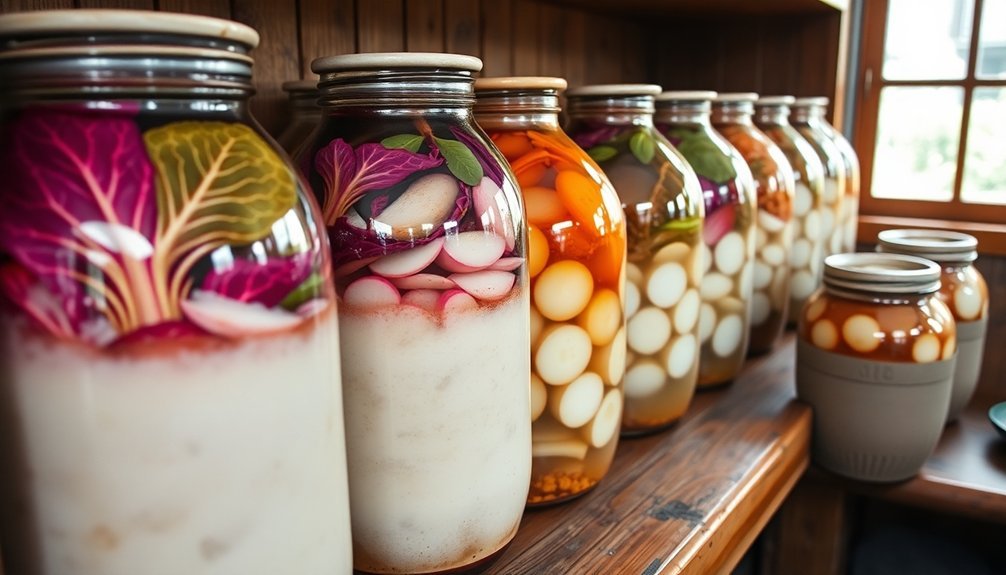
Beyond the common understanding of fermentation as a sugar-based process, indigenous peoples developed sophisticated preservation techniques using diverse organic materials. You'll find that these cultures mastered the art of fermenting everything from animal products to tree saps, creating nutritionally rich foods that sustained communities through harsh seasons.
In the Arctic, you'll discover how Inuit communities perfected the fermentation of seal blubber and seabirds, storing them in natural containers like seal stomachs and skins. Meanwhile, Australian Aboriginal people harnessed complex microbial communities to transform Tasmanian cider gum sap into way-a-linah, showcasing their deep understanding of local ecosystems.
Here's what makes these non-sugar fermentations remarkable:
- Unique microorganisms adapted specifically to each environment, creating distinct flavors and preservation methods
- Natural containers like seal skins and stomachs served as ideal fermentation vessels
- Complex symbiotic relationships between microbes and local materials enhanced nutrient availability
- Seasonal timing and environmental conditions were carefully considered for superior fermentation results
These techniques weren't just about preservation – they represented sophisticated scientific understanding passed down through generations.
Dehydration Methods Across Nations
While fermentation techniques preserved food through microbial activity, indigenous peoples also mastered another powerful preservation method: dehydration.
You'll find this method used extensively across different regions, with each culture adapting techniques to their local environment and food sources.
In the American Southwest, you'll see how the Hopi and Navajo perfected sun and wind drying for fruits and vegetables, while Eastern Woodlands peoples combined sun drying with smoke for enhanced preservation.
If you look to the Pacific Northwest, you'll notice the Tlingit and Haida nations specialized in smoking fish, creating long-lasting preserved seafood.
The storage of these dried foods was just as essential as the drying process itself.
You'd find indigenous communities using specialized storage solutions like clay-lined pits and raised structures to protect their preserved foods.
They'd pack dried goods in containers made from natural fibers and bark, storing them in these carefully designed spaces to prevent moisture and pest damage.
Through these methods, indigenous peoples could preserve their harvest without relying on sugar, maintaining food security throughout the year.
Community Bonds Through Preservation
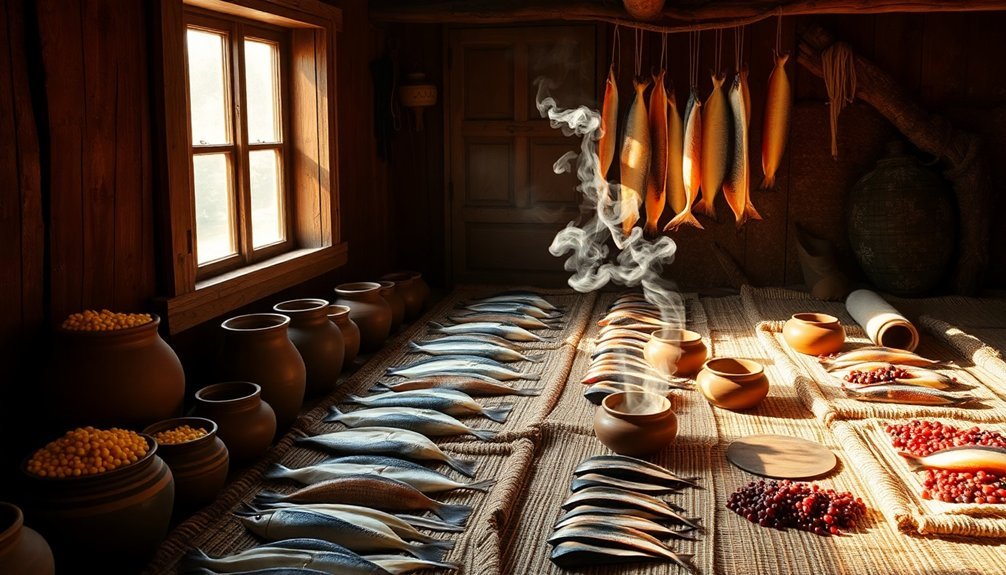
The rhythmic pounding of dried corn and communal songs of harvest gatherings exemplify how food preservation strengthened indigenous community bonds.
You'll find that these preservation activities weren't just about storing food – they served as vital moments for passing down ancestral knowledge and reinforcing cultural identity. When communities came together to preserve their harvest, they'd share stories, techniques, and traditional practices that kept their heritage alive.
During these gatherings, you'd witness:
- Elders teaching youth the precise timing for smoking salmon while sharing oral histories
- Families working side-by-side to prepare meat for winter storage, strengthening intergenerational bonds
- Community members singing traditional songs while processing berries and plants
- Children learning ancestral techniques through hands-on participation in preservation activities
Through these preservation practices, you're seeing more than just food storage – you're witnessing the transmission of cultural values and the maintenance of community health.
Programs like those in the Metlakatla Indian Community continue this tradition today, ensuring that indigenous food sovereignty remains strong while fostering connections between generations.
This communal approach to food preservation hasn't just sustained bodies; it's nourished entire communities and their cultural heritage.
Earth Storage Techniques
When you look at indigenous earth storage methods, you'll see how Native peoples mastered natural cooling by constructing carefully lined pits reaching depths of 6-8 feet below ground.
You'll find these underground storage spaces were engineered with materials like clay, bark, and reeds, creating secure environments that protected dried foods throughout changing seasons.
These storage pits weren't just holes in the ground – they were sophisticated systems that combined natural insulation with strategic construction techniques, allowing communities to maintain their food supplies through winter months.
Natural Underground Cooling Methods
Throughout history, indigenous peoples have mastered natural underground cooling methods for food preservation, harnessing Earth's constant ground temperatures at depths of approximately two meters.
You'll find that these techniques, dating back to ancient civilizations like the Persian and Roman Empires, didn't require complex technology or artificial refrigeration. Instead, they relied on the planet's natural cooling properties to maintain consistent temperatures for storing food.
Here's how traditional underground storage worked in practice:
- Dig storage pits about two meters deep where ground temperatures remain stable
- Layer the bottom with straw or dried grass for insulation
- Place food in sealed containers or wrap in natural materials
- Cover the pit with branches, earth, and additional insulating materials
You can see similar principles at work in various cultures worldwide, from Arctic communities using permafrost for preservation to desert dwellers creating underground storage chambers.
These methods weren't just effective – they were completely sustainable, requiring no external energy input.
Today's earth tube systems and ground-coupled heat exchangers still use these same principles, proving that indigenous wisdom about natural cooling remains relevant in modern times.
Pit Construction and Materials
Ancient wisdom guided indigenous peoples in constructing sophisticated food storage pits that could preserve sustenance for months or even years.
You'll find that these storage systems weren't simply holes in the ground but carefully engineered structures that required specialized knowledge to build and maintain.
The depth of these pits varied greatly among different cultures, from the Lenape's 8-foot-deep caches to Michigan's shallower 4-foot versions.
You'd see these pits strategically placed along trails and hunting routes, making them accessible when needed.
To protect stored foods, indigenous peoples lined their pits with specific materials like clay, bark, or woven reed mats.
What's particularly clever is how they'd clean these pits between uses.
You'd find them using fire to eliminate mold and insects, ensuring the next batch of food wouldn't spoil.
The pits stored everything from nuts and berries to dried fish and wild rice.
When you're building these pits, you'll need to contemplate proper drainage and soil conditions.
It's this attention to detail that allowed some pits to remain functional for centuries, serving multiple generations with reliable food storage.
Seasonal Storage Solutions
Indigenous communities routinely relied on diverse earth storage techniques that adapted to seasonal changes and local environments. You'll find these methods were particularly important during winter months when fresh food became scarce. Traditional storage solutions included structures like kodambae and kuthir, which protected food supplies while allowing controlled access throughout the year.
During high precipitation seasons, you'd see communities actively preparing for leaner times by implementing various preservation techniques. They'd utilize natural cooling properties of earth-based storage systems while maintaining proper ventilation to prevent spoilage.
- Deep earthen pits lined with dried grass and bark, creating natural insulation
- Multi-layered storage chambers that regulated temperature and humidity
- Ventilated underground rooms with wooden platforms to keep food off the ground
- Strategically placed storage areas near water sources for temperature control
These seasonal storage solutions weren't just practical – they represented sophisticated understanding of environmental factors. You'd find communities using dobas for water collection during monsoons, while agroforestry techniques protected storage areas from erosion and extreme temperatures.
This systematic approach guaranteed food security through careful adaptation to seasonal changes.
Natural Antimicrobial Preservation Methods
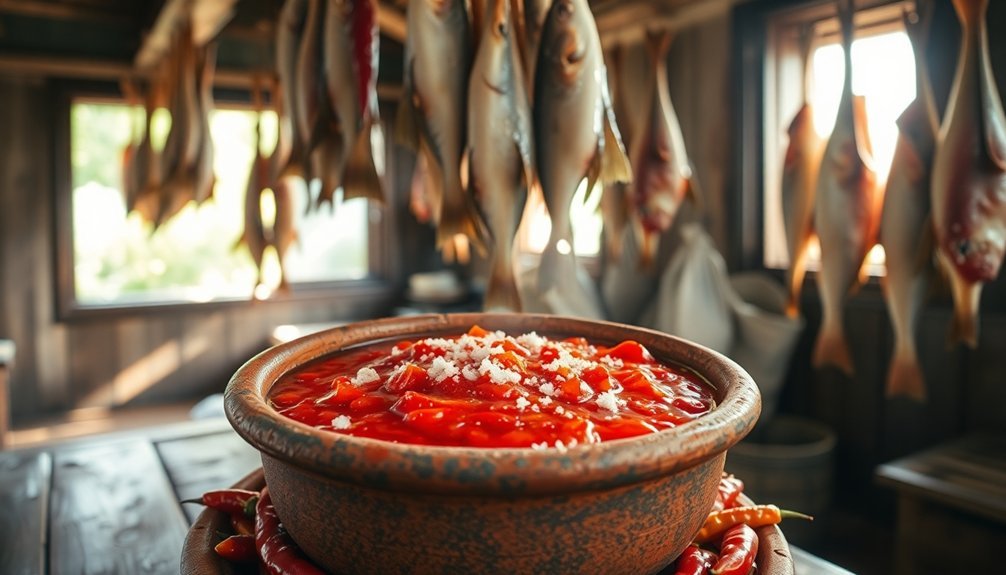
From ancient times to today, natural antimicrobial preservation methods have played an essential role in extending food shelf life. You'll find that indigenous cultures discovered numerous plant-based compounds that naturally fight harmful microorganisms. Essential oils from herbs like oregano, sage, and lemongrass don't just add flavor – they actively inhibit microbial growth and protect food from spoilage.
| Compound | Source | Benefits |
|---|---|---|
| Chitosan | Crab/shrimp shells | Creates protective barrier, reduces moisture loss |
| Vanillin | Vanilla beans | Maintains food quality, stops mold growth |
| Essential Oils | Herbs/spices | Inhibits bacteria, extends shelf life |
| Plant Compounds | Various plants | Suppresses microbes, preserves nutrients |
When you combine these natural preservatives with traditional techniques like salting and smoking, you'll get even better results. Modern research shows that these combinations can double food's shelf life while maintaining its nutritional value. For example, when you coat fresh-cut apples with apple puree-alginate containing lemongrass oil, you'll preserve both freshness and flavor. These methods don't just work – they're also safer and more sustainable than many modern chemical preservatives.
Sustainable Food Security Systems
Building on these natural preservation methods, sustainable food security systems developed by Indigenous peoples offer remarkable insights into environmental stewardship and community resilience.
You'll find these systems weren't just about food storage – they represented a deep understanding of ecological cycles, resource management, and community wellbeing.
Indigenous communities developed sophisticated approaches that you can still learn from today:
- Seasonal harvesting and preservation cycles that matched local ecosystem patterns
- Community-wide preservation events that strengthened social bonds while processing food
- Multi-generational knowledge transfer through hands-on participation in preservation activities
- Adaptive techniques that responded to environmental changes and resource availability
You'll notice these systems went far beyond mere sustenance. They're integrated approaches that guaranteed year-round food security while maintaining cultural identity and environmental balance.
The preservation methods didn't just keep food edible – they enhanced nutritional value and created distinct flavors that became central to cultural traditions.
Today's efforts to strengthen Indigenous food systems focus on protecting these practices through research, education, and legislation, recognizing their crucial role in building resilient and sustainable communities.
Frequently Asked Questions
How Did Indigenous Peoples Test if Preserved Foods Were Still Safe to Eat?
You'll find indigenous peoples tested food safety through visual inspection for mold, smell tests for spoilage, small taste tests for off-flavors, and texture checks, while relying on ancestral knowledge passed through generations.
What Specific Herbs Were Used Alongside Preservation Methods to Enhance Shelf Life?
You'll find it challenging to identify specific herbs since historical records are limited. However, indigenous peoples commonly dried herbs with food, though exact varieties used for preservation aren't well documented in available sources.
How Did Different Climate Zones Affect Preservation Technique Choices Among Indigenous Peoples?
You'll find that climate directly shaped preservation methods – arid regions favored sun-drying, tropical areas relied on smoking and salting, coastal communities used fermentation, while mountain dwellers utilized cold temperatures and wind-drying techniques.
Which Preservation Methods Were Specifically Used for Medicinal Plants and Herbs?
You'll find indigenous peoples used drying, selective harvesting, and specialized storage in cool, dry places. They'd also document preparation methods and protect herbs through domestication to maintain medicinal potency and guarantee sustainability.
How Did Indigenous Communities Trade Preserved Foods Between Different Ecological Regions?
You'll find that Indigenous communities used established trade networks to exchange preserved foods across regions, carrying dried meats, smoked fish, and fermented products in leather pouches and baskets along well-traveled routes between communities.
In Summary
You've discovered that Indigenous cultures mastered preservation without sugar through deep environmental knowledge and community practices. Their methods – from salt curing to smoking, fermentation to earth storage – weren't just practical but sustainable. They're proof that effective food preservation doesn't require modern additives. You can still learn from these time-tested techniques that connected people to their land and each other.

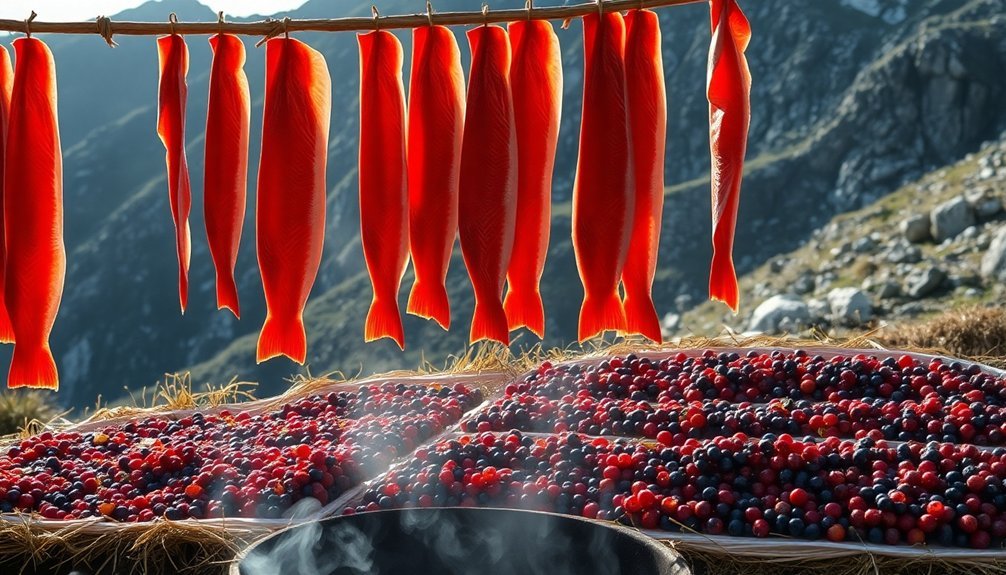



Leave a Reply